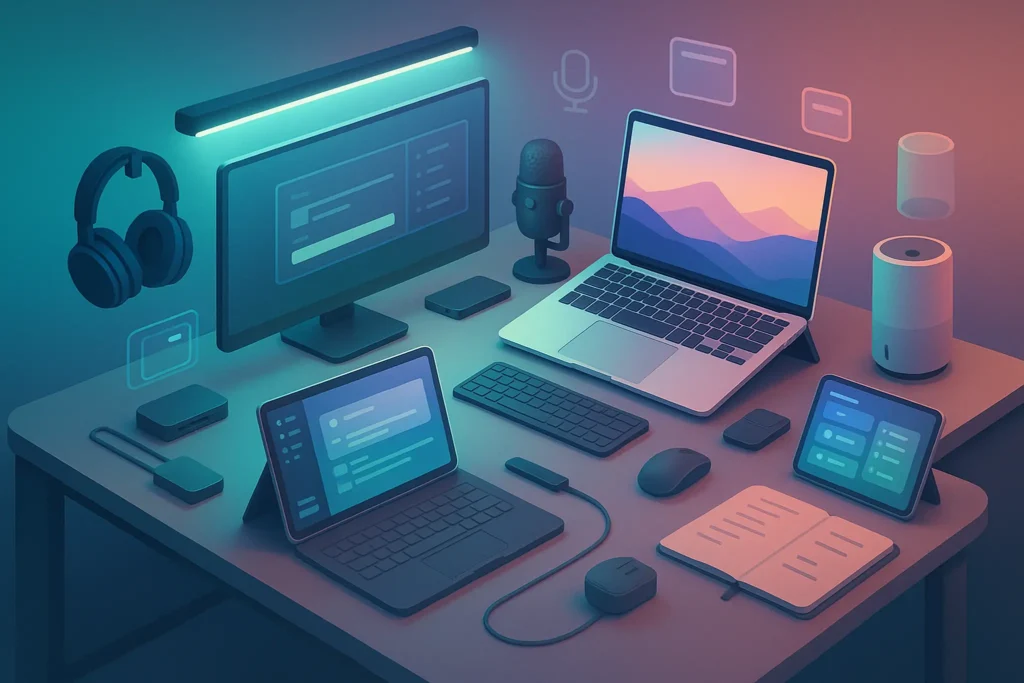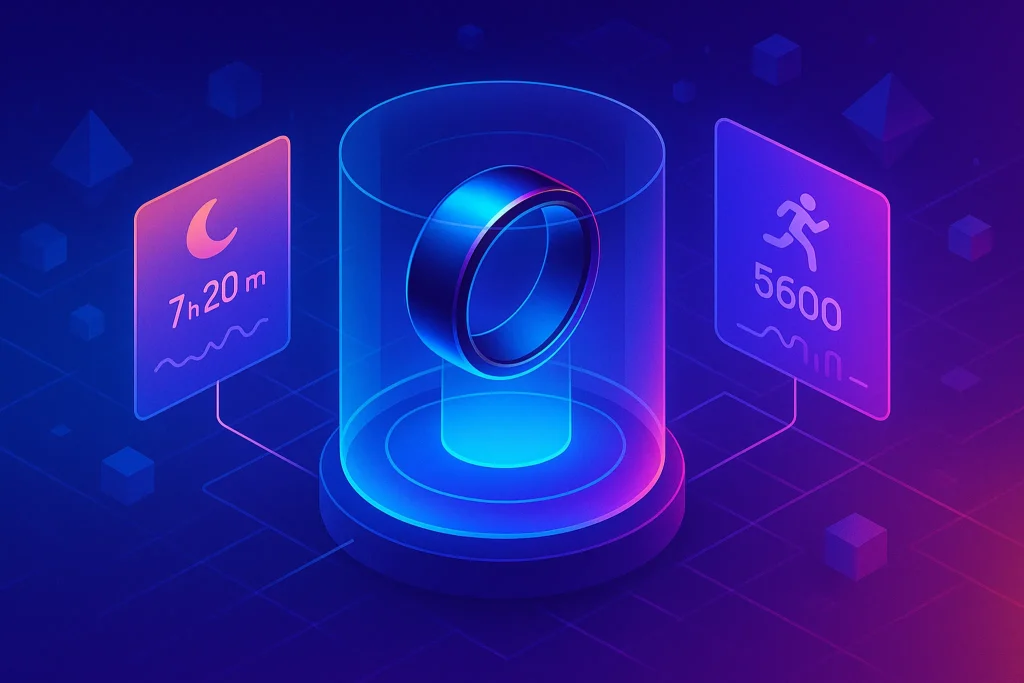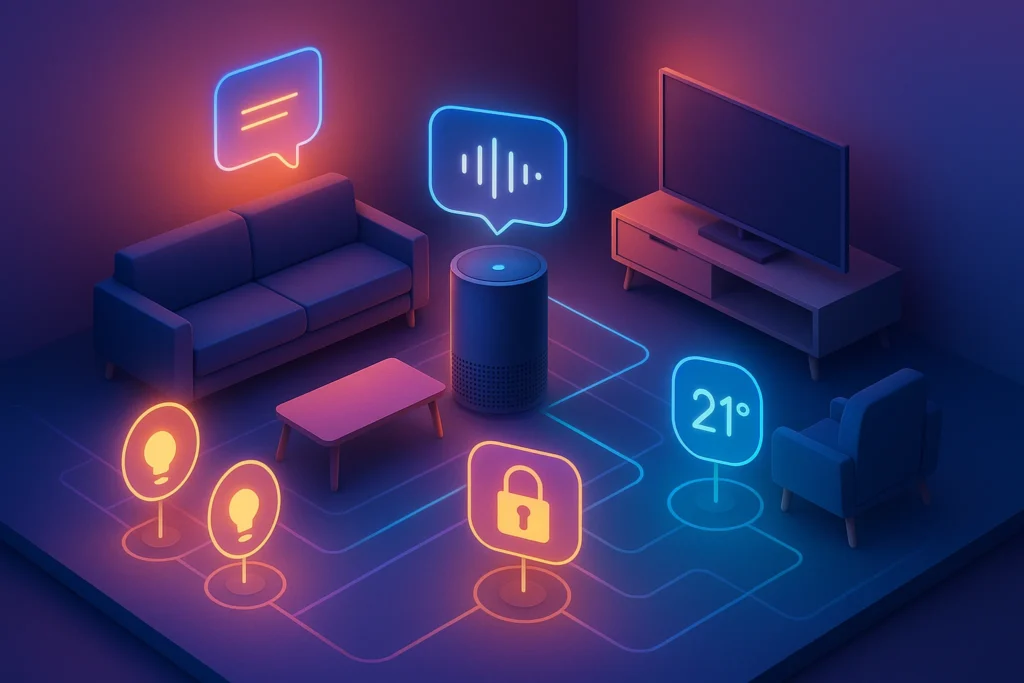-This post may contain affiliate links. If you click on one and make a purchase, I may earn a small commission at no extra cost to you.-
🔍 Introduction: Work From Home, But Smarter
Creating a productive home office isn’t just about a desk and good Wi-Fi—it’s about having the right tools that boost focus, comfort, and communication. A simple gadget like a docking station or a portable monitor can transform your workflow. Whether you’re optimizing for clarity with noise-canceling headphones or improving ergonomics with laptop stands, this guide breaks down what matters—and why.
If you’ve already set up basic tools from our Best Smart Home Gadgets Under $100 list or followed our tips in Work‑from‑Home Productivity: How to Stay Focused, you’re ready to level up. Let’s dive in.
Remote work isn’t just a trend anymore—it’s a new lifestyle. But without the right tools, your home office can quickly become a pain zone of distractions, discomfort, and lost productivity.
Whether you’re a digital nomad hopping between cities, or a full-time remote worker managing Zoom meetings and deep-focus workdays, the gadgets you surround yourself with define your performance. In this guide, we’ve handpicked the best tech gear under six essential categories—from comfort to backup—so you can work smarter, healthier, and more efficiently.
🪑 1. Comfort: Ergonomics Matter More Than You Think
Working 8+ hours from your bed or dining chair? That’s a recipe for long-term physical burnout. Comfort-centric gadgets are the foundation of a sustainable remote setup.
Laptop Stand – Roost Stand / MOFT Z
Raises your screen to eye level—reducing neck strain and improving posture.
A good laptop stand elevates your screen to eye level, reducing neck and shoulder strain. The Nexstand K2 is ultra-lightweight and collapsible—perfect for remote workers on the move.
Use-Case: Productivity consultant Anna travels with the foldable MOFT; in coffee shops or coworking spaces, she sets her laptop at desk height and maintains good ergonomics all day.
A freelance writer using their laptop 10 hours a day avoided constant neck pain after switching to a stand that adjusted their posture and opened up desk space for an external keyboard.
First-Person Insight: I used to slump over spreadsheets—now the stand helps me feel alert and aligned, even during marathon remote sessions.
Ergonomic Chair – Hbada Swivel or SIHOO
Supports lumbar region and seat depth for long stints at your desk.
Often overlooked, a footrest improves circulation and posture. This memory foam model supports extended sitting, especially for shorter users whose feet dangle when seated.
Use-Case: Developer James replaced his flat office chair; after two hours of coding, he no longer feels soreness in his lower back.
A remote manager working long shifts noticed reduced back tension and fewer leg cramps after adding a simple footrest under their desk.
First-Person Insight: I didn’t expect a chair to matter so much—but after a week, my daily aches were gone.
Footrest – Everlasting Comfort
Keeps your legs aligned, reducing pressure on your lower back.
Use-Case: Writer Mia uses it to add support during long article writing sessions.
First-Person Insight: Little ergonomic upgrades like this make a major difference by late afternoon fatigue.
🎧 2. Focus: Kill Distractions, Build Flow
In a home office, distractions come in all forms—noisy neighbors, notifications, and harsh lighting. These gadgets help create a focused zone.
Noise-Cancelling Headphones – Sony WH-CH720N
Block out the world. These ANC headphones mute everything from construction noise to family chatter, helping you drop into deep work mode faster.
Affordable ANC headphones tuned for work environments.
Use-Case: Analyst Steven uses them to drown out apartment sounds while jumping between video calls.
A software engineer with kids at home uses the WH-1000XM5 to carve out mental space and mimic the feeling of working in a quiet office—even during chaotic mornings.
First-Person Insight: Quiet mid-day became quiet productivity—ANC made focusing achievable without isolation.
Smart Light Bar – BenQ ScreenBar Plus
Smart light bars reduce eye strain and create ambient focus environments with customizable lighting. Many also adjust brightness based on time of day.
Automatically adjusts color temperature and brightness to match your circadian rhythm.
Use-Case: Graphic designer Casey uses it to reduce eye fatigue while editing visuals.
A content creator set up a Govee RGB bar to switch from “writing white” to “editing blue” with a single voice command, creating visual signals for different tasks.
First-Person Insight: My evenings feel calm and focused, not harsh like overhead bulbs, which disrupt my evening routine.
💡 Nerd Tip: Check our Work-from-Home Productivity: How to Stay Focused post for more mindset and habit upgrades.
📞 3. Communication: Look Sharp, Sound Sharp
Poor audio or grainy video kills professionalism. Investing in gear that upgrades how you show up online pays off immediately—especially if you’re client-facing or in daily meetings.
HD Webcam – Logitech C920e
Webcams on most laptops are still stuck in 2013. A standalone 1080p or 4K webcam drastically improves your video presence with better clarity, light balance, and frame rate.
Deliver sharp 1080p video and autofocus—essential for professional virtual meetings.
Use-Case: Sales rep Maria relies on it to make herself warmly visible during client pitches.
A remote recruiter switched from their MacBook’s webcam to the Logitech C920x and instantly received compliments during calls—“you look super clear now!”
First-Person Insight: My personal interactions improved—we realized I was habitually turning off my camera due to bad quality. Not anymore.
USB Microphone – Fifine K669B
Clear audio is often more important than video. A good USB mic prevents echoes, muffled sound, and “Zoom fatigue” for your listeners.
Clear voice capture without echo—earns credibility in meetings and recordings.
Use-Case: Project manager Alan delivers training sessions from home with confidence.
A podcaster and online teacher uses the FIFINE K690 for both course recordings and live coaching—delivering crisp, warm audio that builds trust.
First-Person Insight: I stopped leaning in—my voice just carries better now.
Ring Light – Ulanzi VL49
Even with a good webcam, bad lighting makes you look tired or distracted. A soft ring light fixes shadows and enhances your facial expression on video.
Eliminates shadows and enhances visual presence on camera.
Use-Case: Content creator Sophia lit up her kitchen desk for cooking tutorials.
An online consultant running back-to-back calls uses a ring light for consistent, flattering visuals—especially in winter months with poor natural light.
First-Person Insight: Two-minute setup, three more comments about my “clearer lighting.” Worth it.
⌨️ 4. Productivity: Optimize Your Output
Docking Station – Anker 7-in-1 or CalDigit Mini
For anyone with multiple devices, extra monitors, or accessories, a solid docking station is the nerve center of the workspace. These hubs deliver power, Ethernet, audio, and USB all in one place.
Expand connectivity with USB-C, HDMI, Ethernet, and power delivery.
Use-Case: Software engineer Vikram switches his laptop to dual monitors instantly.
A project manager working across Mac and Windows connects everything—keyboard, SSD, monitors—with a single USB-C cable via a dock, enabling instant setup at any desk.
First-Person Insight: I love closing my laptop and walking away—everything reconnects seamlessly when I return.
Portable Monitor – Lepow or ASUS ZenScreen
Add a second screen wherever you are. These ultra-light monitors make multitasking and presentations easier, especially for those who work from cafés, co-working spaces, or on the road.
Adds a second screen on the go, ideal when working on grants or spreadsheets.
Use-Case: Remote researcher Layla moves between home and coffee shop—monitor plugs in, and she’s ready.
A remote data analyst uses a ZenScreen during travel to compare spreadsheets side-by-side without constantly alt-tabbing—cutting down reporting time and screen fatigue.
First-Person Insight: I have screen space and context without lugging a bulky desktop.
Wireless Keyboard/Mouse Combo – Logitech MX Keys Mini + MX Anywhere 3
Typing on a laptop keyboard long-term is brutal. A responsive, ergonomic combo can reduce fatigue and boost typing speed. If aesthetics matter, go for a low-profile mechanical like Keychron.
Compact, precise, and battery-efficient for wire-free workflow.
Use-Case: Freelancer Joanna toggles between iPad and laptop—keyboard pairs with both instantly.
A marketing specialist who frequently switches between typing, designing, and editing found that having a quiet, tactile keyboard paired with a smooth mouse cut their workflow time by 20%.
First-Person Insight: The travel-friendly vibe makes writing easy anywhere—even on the sofa.
It’s not just about working more—it’s about working better. The right productivity gear eliminates bottlenecks, supports multitasking, and helps maintain momentum throughout the da
🌱 5. Environment: Make Your Space Healthier
You’re spending more time at home than ever. Make sure your work environment is supporting your body and mood, not draining it.
Smart Air Purifier – Levoit Core 300S
Indoor air is often worse than outdoor air. A smart purifier reduces dust, allergens, and VOCs—and some even auto-adjust based on air quality.
Monitors and improves indoor air quality via your phone.
Use-Case: Allergy sufferer Tom noticed better focus during peak pollen seasons.
A remote developer with allergies found significant improvement in breathing, focus, and sleep after adding a purifier that syncs with their smart home system.
First-Person Insight: Knowing the air is actually clean—even with windows closed—brings silent reassurance.
Temperature Monitor – Govee H5075
Knowing your exact room conditions can help you adjust humidity, light, or temperature to stay in your cognitive performance zone.
Tracks room temp and humidity, sends alerts if conditions change drastically.
Use-Case: Freightware engineer Lisa ensures stable conditions for her sensitive hardware.
A UX researcher tracks temp and humidity fluctuations in their shared flat to adjust comfort and avoid mid-day energy crashes caused by overheating.
First-Person Insight: It’s like my room finally communicates with me—and sends early warnings before it’s too hot.
Desk Humidifier – ASAKUKI 300ML
Dry indoor air can cause eye strain and fatigue—especially in heated or air-conditioned rooms. A small humidifier adds needed moisture to your breathing zone.
Prevents dry air in winter, improves comfort and vocal clarity during calls.
Use-Case: My voice felt less raspy during back-to-back Zoom days when I used this discreet unit.
A content writer working through winter months saw fewer headaches and less dry skin after placing a mini humidifier beside their monitor.
First-Person Insight: I barely notice its presence until I wake up with less throat irritation.
💡 Nerd Tip: You might also enjoy our Best Smart Home Gadgets Under $100 guide—great picks that overlap with productivity gear.
Portable SSD – Samsung T7 or SanDisk Extreme Portable
Fast, compact backup for documents, code, and media.
Use-Case: Digital nomad Ethan backs up every day before checkout—no panic when Wi-Fi is flaky.
First-Person Insight: Losing hours of typed work is awful—backup has become a habit, not a chore.
Surge Protector / Mini-UPS – APC Back-UPS BE600
Protects gear from power spikes and provides minutes of power when outlets fail.
Use-Case: In unstable power areas, Maria’s system can auto-save projects before shutoff.
First-Person Insight: I once lost a day’s editing; a fuse made the difference the next time.
💾 6. Backup & Stability: Never Lose Your Work Again
One power blip or corrupted file, and your day’s work is gone. Backup and stability tools give you peace of mind—and they’re not just for IT nerds.
🔹 Portable SSD: Samsung T7 / SanDisk Extreme
Fast, pocket-sized, and reliable. Ideal for backing up project files, transferring large media, or using as external scratch drives.
Use Case:
A graphic designer syncs all client assets to a 1TB SSD every week—ensuring offline access and faster loading when editing large files.
🔹 Surge Protector: Anker PowerExtend / Belkin Pivot Plug
Power surges can fry your tech. A high-quality surge protector guards your gear and adds multiple outlets for your workstation.
Use Case:
A remote startup founder uses one to protect their laptop, monitor, mic, and Wi-Fi gear—avoiding expensive losses during summer storms.
🔹 Mini UPS Battery: TalentCell / APC BGE50ML
A mini-UPS keeps your router and laptop alive for 30–90 minutes during outages—enough to save work or finish a call.
Use Case:
A freelancer in a region with unstable electricity depends on a mini UPS to keep Zoom calls running smoothly during brownouts or short cuts.
📊 Mini Comparison Table
| Gadget Category | Top Pick | Key Benefit | Price |
|---|---|---|---|
| Comfort | Laptop Stand | Posture & eye-level setup | ~$40 |
| Focus | Sony ANC Headphones | Blocks noise, boosts concentration | ~$100 |
| Communication | Logitech C920e + Mic | Clarity on video & voice | ~$45 + $45 |
| Productivity | Anker Dock + Lepow | Expandable workspace | ~$150 |
| Environment | Levoit Purifier | Cleaner air, less allergy | ~$90 |
| Backup | Samsung T7 SSD | Secure, fast portability | ~$90 |
| Power Protection | APC UPSMini | Prevents data loss | ~$80 |
🧠 Nerd Verdict
Upgrade your setup with intention. Start with a supportive chair and laptop stand for posture, add a camera/mic combo for professional calls, and finish with tools to protect your time (backup, UPS). Choose what aligns with your workflow—not hype. Each bit adds practical value that shows up in productivity and health.
Remote work in 2025 is about designing your environment with intentionality. It’s not just aesthetics—it’s performance, health, and peace of mind.
After testing dozens of gadgets across six categories, our top essentials include:
-
🎧 Sony WH-1000XM5 for focus
-
🪑 Hbada Office Chair for comfort
-
🔌 Anker Docking Station for productivity
-
🌬️ Levoit Smart Purifier for health
-
💾 Samsung T7 SSD for backup
If you’re serious about remote work, even just adding 2–3 of these can transform your day-to-day experience.
❓ FAQ: Nerds Ask, We Answer
Q: Which remote work gadget should I buy first on a tight budget?
Start with a laptop stand + external keyboard/mouse—they’re low-cost upgrades with big ergonomic impact.
Q: Are expensive noise-canceling headphones really worth it?
If you’re easily distracted or work in shared spaces, yes 100%. They pay off in focus and sanity.
Q: What’s the best gadget for improving video calls?
A USB mic often improves perceived call quality more than a webcam—audio clarity matters most in communication.
Q: How can I keep my workspace healthy?
Prioritize air quality and posture. Add a smart air purifier, proper chair, and adjust your screen height and lighting.
Q: Do I need all of this at once?
A: Not at all. Prioritize comfort and communication first, then build with focus and productivity tools as needs grow.
Q: Are wireless keyboards/mice secure over Zoom?
A: Modern combos (e.g., Logitech’s) use encrypted signals—no noticeable lag or latency.
Q: Is a UPS necessary if I have a surge protector?
A: UPS adds a brief battery backup to save work safely during outages—not just block spikes—essential in frequent blackout zones.
💬 Would You Bite?
If you could add one gadget to your setup today, what would it be—and why? What’s the one gadget that changed your remote work game?
Share your setup or your favorite upgrade in the comments—we might feature it in our next gear list! 👇



